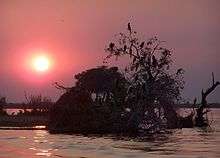Caprivi
The Caprivi, also known as Caprivi Strip is a long, skinny panhandle extending north-east from Namibia, separating Angola (to the north), Botswana (to the south), and ending near the south-western corner of Zambia.

Cities
Other destinations
- 🌍 Bwabwata National Park — the largest of the region's parks, composed of the former "Caprivi Game Park and ex "Mahango Game Reserve"
- 🌍 Mudumu National Park
- 🌍 Nkasa Lupala National Park (ex Mamili) — a swampland region that is not particularly well-known
Understand
The Caprivi Strip is named after German Chancellor Leo von Caprivi who acquired it from Great Britain in 1890 for the German colony of German South-West Africa (Namibia) in order to have a river connection to the German colony of Tanganyika. The connection proved unsuccessful, due to the Victoria Falls. Due to the colonial connotation the are is officially called Zambezi Region in Namibia but tourists and tourist maps still commonly call it the Caprivi.
There was a conflict in Caprivi in 1999, but it lasted only a few days, and the strip has been peaceful since then.
It is a tropical, wet stretch of land, known for its typical round huts along the street.
Talk
You will mostly hear the locals speaking their local language. English is almost the only foreign language spoken. Other local Namibian languages such as German and Afrikaans are not spoken or understood by the locals.
Get in
By air
There are some small landing strips in the far part of the strip, but otherwise the best way in is by road.
By road
Due to the scarcity of other options, most travellers will arrive by car. The major highway in the region is the B8 which is part of the Trans-Caprivi Highway. Travellers from Zambia will cross the bridge over the Zambezi at Sesheke to get into Katima Mulilo. Travellers from Botswana will cross the bridge over the Chobe to get into Ngoma.
By public transport
Between towns you can catch a minibus. Katima Mulilo is on the route of the big coaches that travel between Windhoek and Lusaka.
By boat
There are a few river crossings into Angola, Zambia, and Botswana; they do not follow a fixed schedule.
Get around
The B8 is tarred and in very good condition. The C48 from Botswana to Bagani is a gravel road and in fair condition, easily passable with an ordinary sedan. Other roads (D-roads and those without letters or numbers) tend to be rough, sandy, heavily corrugated, and muddy after rainfall. The roads in the wetlands east of Katima Mulilo will normally require a 4x4. During the rainy season (Oct-April) they might not be passable with any type of car, phone your host to enquire about road conditions.
See

Do
The Caprivi is a game-rich area and includes three wonderful national parks which are still somewhat under-utilized in comparison to the parks in neighboring Botswana.
Take a game drive, camping trip or boat cruise in any of the parks.
For additional on the parks and downloadable brochures go here:
Eat
Drink
Sleep
Mashi River Safaris, Kwando river
- Nkasa Lupala Tented Lodge, Sangwali/Mamili NP (GPS: S18 19.766 E23 40.324), e-mail: info@nkasalupalalodge.com.
Stay safe
All of northern Namibia, and particularly the tropical Caprivi, is a Malaria risk zone. Take the necessary precautions.
The Caprivi is famous for its many elephants. Don't drive too close, and don't drive too fast, even (and particularly) on the B8. Unless accompanied by a screeching halt, 10-15 m will normally not put your party in danger and is close enough for good holiday pictures. Come any closer and the younger elephants might play with your car, the older ones might get angry, either way your car might end upside down. You'll know that an elephant is angry when he shakes his head. In this case, stay in the car, switch off the engine, and avoid all unnatural noise (cell phone, camera, such things). They will eventually walk away; wait for this to happen instead of trying a daring escape.
The Kavango River also has crocodiles and hippos. It is not safe to swim there. Outside the settlements it is not safe to even go near, as hippos are both aggressive and territorial and can easily outrun a human on land.
Namibia has the larges variety of poisonous snakes on the planet, and many inhabit the Caprivi. Specifically, the Black Mamba and the Mozambique spitting cobra are more common in this region than you may think. Be extra careful, even when in the premises of a lodge, or even in your room or dining area.
Go next
- In the south lies Botswana and its natural wonders, the Okavango Delta and the Chobe National Park.
- The Victoria Falls are not far away from the Caprivi Strip. Depending which side of the Falls you want to visit, you can reach the Zambian side by crossing the border at Katima Mulilo over Sesheke Bridge. From there the Falls are about 200 kilometres (120 mi) to the east, on a road that is so terrible that you might not have seen anything like it before. Expect to spend an entire day on this
roadchain of potholes. To reach the Zimbabwean side you cross the border into Botswana at Ngoma. The 90 kilometres (56 mi) stretch of road from there to the Falls is tarred and decidedly better. - Further west is the Etosha National Park